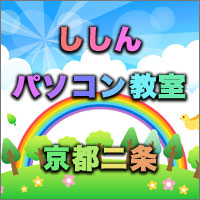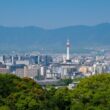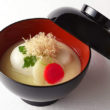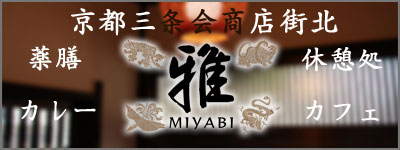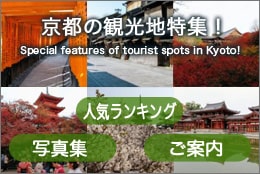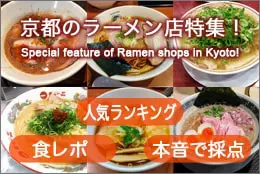“Welcome to Morita Farm.” What makes Kamo Kyoto vegetables so appealing?
Posted date:2025-07-18Author:つばくろ(Tsubakuro) Transrator:ポンタ(Ponta)
Category:Talk about Kyoto
広告
adsense4
To begin with:
Something my friend who lives in Iwakura, Kita Ward, had been saying for some time.
“There are vegetable vending machines scattered around near Deep Mud Pond.
The other day when I passed by, they had big, nice daikon radishes for 170 yen. I couldn’t resist buying one, took a picture, and showed it to a friend. As soon as they she saw it, she rushed out to buy some too.”
Even though it was a vegetable vending machine, I didn’t get it at the time, so I didn’t ask for many details.
However, in mid-June, that friend went on to say this:
“I found Kamo eggplants at a vending machine. They were 300 yen each.”
Upon hearing “Kamo eggplants,” Columnist reacted instantly.
-And no wonder, for Columnist fond of Kamo eggplants.
As many of you know, Kamo eggplant is the king of Kyoto summer vegetables, highly valued as a gift.
It tastes and looks excellent.
But that means they are expensive in the city.
“Vending machines, vending machines – where exactly are they?”
“Where is …? There are many of them around Deep Mud Pond. At this time of year, most vending machines have them, right?”
This incident prompted the columnist to get serious and decide to look into vegetable vending machines.
I live in Nakagyo Ward, so it’s true I’m not very familiar with Kamigamo. Even so, I sometimes have business that takes me to Kita Ward once or twice a month.
Then, that friend said again.
“There’s a vending machine right next to “Oideyasu” where you always drive by. I don’t know much about that particular machine, but if you’d like, why not get out of the car and take a closer look?”
Upon hearing this, the columnist felt like clapping the hands in delight.
That’s because “Oideyasu Morita Farm” was a shop I had fond of memories of, having shopped there many times before.
Son cultivates, mother sells – traditional Kamigamo specialty “Oideyasu Morita Farm”

The exterior of the shop “Oideyasu”
I used the facility for the first time 20 years ago from now.
One early winter day, when I visited Kamigamo with my mother on an errand, I spotted some splendid pickled mustard greens displayed in front of a shop and bought them. I bought it partly because the price was less than half that of a famous pickle shop, but when I tried it, it had a pleasant sourness and a unique crunch – it was incredibly delicious. I liked it so much that I’ve been a repeat customer ever since. I heard that the son cultivates Kamo Kyoto vegetables in the field behind the shop, and the mother sells the freshly harvested produce there. It was a shop where Kyoto vegetables in season – spring, summer, autumn, and winter – were lined up in abundance.
Not only vegetables, but also the aforementioned suki pickles, nuka-pickled Chinese cabbage, and home-grown shiso-pickled umeboshi plums were abundantly displayed at this shop.
Sometimes, pure honey was sold, and it was quite useful for our household.
“Oideyasu Morita Farm” and the vending machine
As such, the genuine direct-sales shop, “Oideyasu Morita Farm”, whose mother who had always tended the store fell ill about ten years ago and could no longer come to the shop, has since then shut the front tightly whenever I passed by.
At the time, my family deeply regretted the store’s closure, but with no signs of people around, the years simply passed by.
Well, my friend says there’s a vending machine set up right next to that shop.
I the columnist would like to go check it for sure for myself.
Then, while visiting Kamigamo in early July, I stopped by “Oideyasu Morita Farm.”
I got out of the car and looked around – there it was!
This was the Kyoto vegetable vending machine I’d heard so much about.
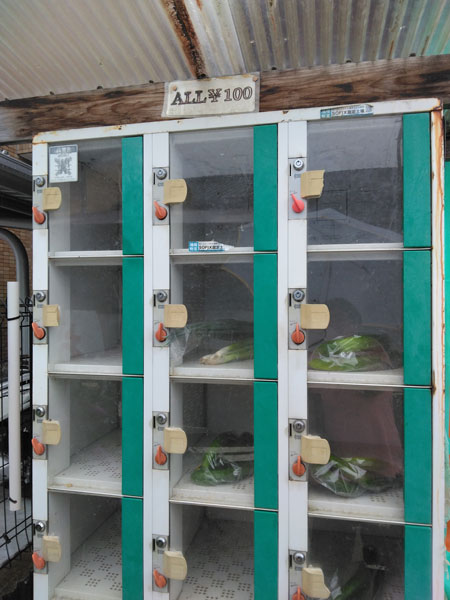
The vegetable vending machine
Above the vending machine, the words “All 100 yen!”
Peering inside the vending machine, I could see thick cucumbers (3 per pack), large tomatoes, and shiny eggplant (3 per pack) neatly arranged.
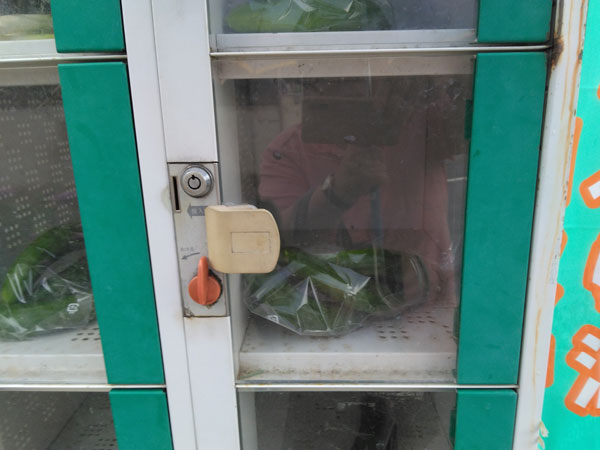
The door of the vending machine with the cucumbers in
While taking a photo in front of the vending machine, a man appeared out of somewhere.
“What would you like?” he asked, so I replied, I’d like some Kamo eggplants, though it’s not in the vending machine.” Then he beckoned me over, saying, “We have some over here – go ahead and pick whichever you like.”
Inside the storage room I was led to, there was a mountain of Kamo eggplants piled up.
“With this heat, if we leave them out, we’ll have to throw them away anyway. So 100 yen each is fine. Take whatever you like home.
There’s no choice but to discard them. … Ture, the color and sheen are somewhat inferior, but the taste should be just as good.
This is a bargain!
Needless to say, the columnist bought it with great delight.
When I paid, I asked, “Is the old lady of the shop doing well?” and was told, “She passed away four years ago.”
The Kamo Kyoto vegetables I asked Mr. Morita
Not long after that, a friend living in Tokyo asked me to send them Kamo eggplants and Manganji peppers, so I visited “Oideyasu Morita Farm” once again.
The person who showed me around was younger than the one I met last time.
Upon being led into the old store, boxes filled with freshly harvested vegetables stood arranged inside: fine, authentic Kamo eggplants, plump Manganji peppers, stately eggplants, glossy tomatoes, and thick cucumbers.

Kamo eggplants

Ordinary eggplants
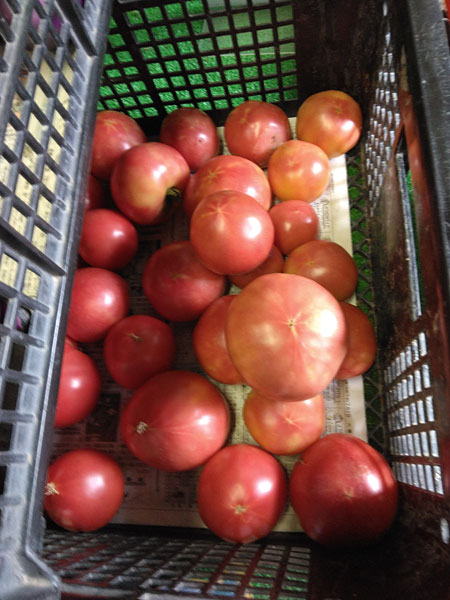
Tomatoes
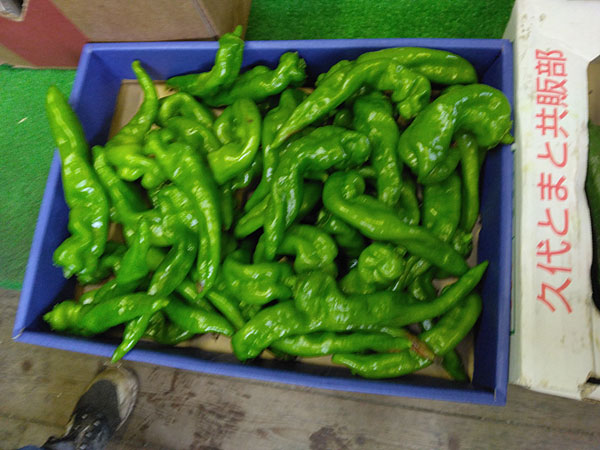
Manganji peppers
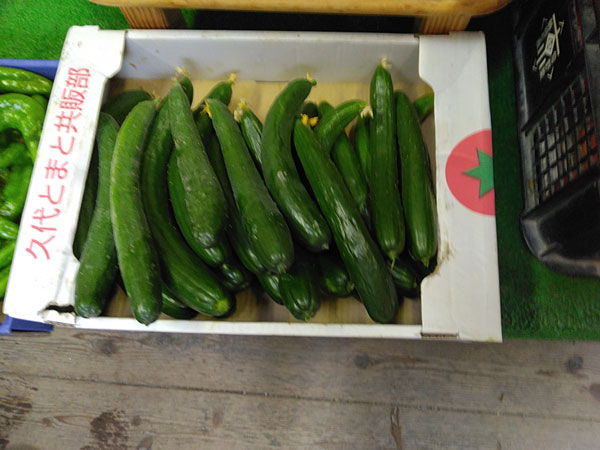
Cucumbers
With these vegetables before me, I’ll hear from Koji Morita of “Oideyasu Morita Farm” about various things.
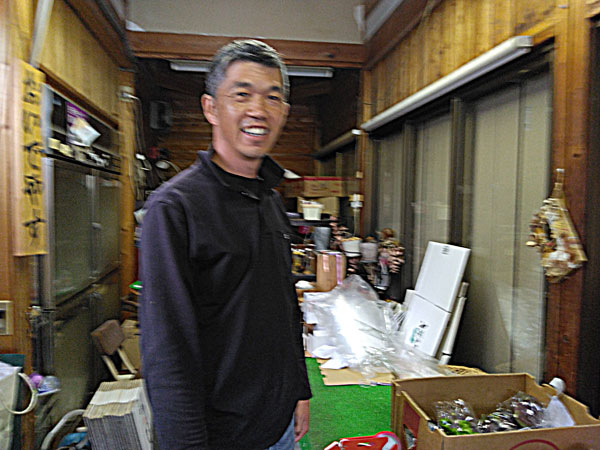
Mr. Morita
(The person the columnist met in front of the vending machine last time was the father.)
“I only recently learned about vegetable vending machines. When was this started?”
“Actually, it started after COVID-19 began spreading. The traditional door-to-door sales we’d been doing were deemed dangerous as face-to-face sales, so the government banned them. Instead of street vendors, vending machines were installed per government directive.”
“So, do the farmers in Kamigamo no longer do the traditional door-to-door sales?”
“No, they do. We go to Higashiyama Ward to sell.”
“You, Mr. Morita?”
“No, not me – my mother did. She drove a truck to Higashiyama Ward. Originally, my late grandmother used to pull a cart and go peddling door-to-door, but …Her legs were getting weaker and the work was getting too hard, so we stopped selling door-to-door and started a direct sales outlet. At that time, direct sales outlets were quite rare, I think. That grandmother passed away, and now my mother sells from a truck.
Furiuri refers to itinerant vendors selling Kyoto vegetables harvested in Kamigamo.
This method of trade traces its origins back to the distant Heian period, and until around the mid-1970s, the traditional attire consisted of a navy cotton kosode undergarment and a three-panel apron. In the past, it was common to see vendors pushing handcarts to sell their produce but recent years, the practice has shifted to driving trucks.
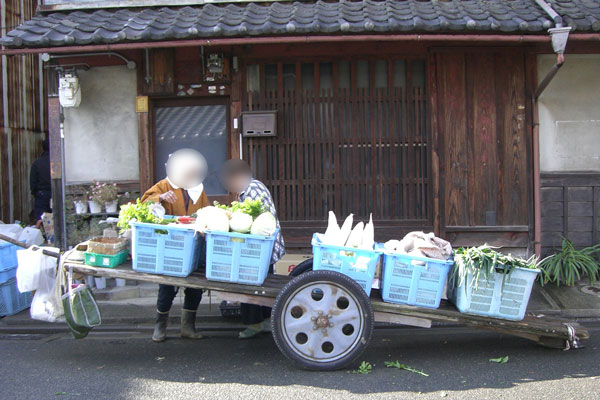
Furiuri in the past
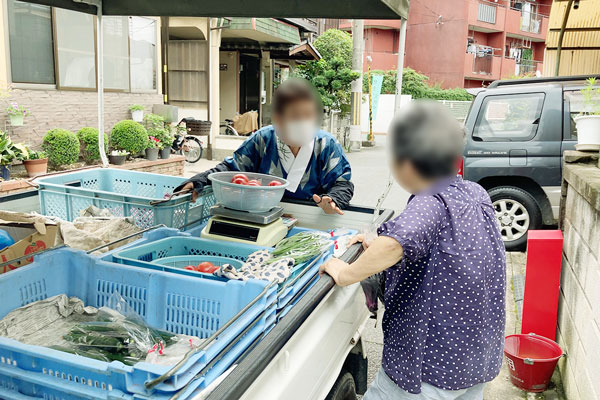
Today’s truck-using Furiuri
“Do the farmers each set their own prices for the vegetables sold in vending machines?”
“Yes. The vegetables we put in our vending machines tend to be imperfect produce… They taste just fine, but maybe the color is a bit off, or the cucumbers are slightly bent.
That’s why everything sold here is by 100 yen. Some farmers are selling regular ones for 300 yen. It varies.”
“Where are the vegetables from Kamigamo mainly sold these days?”
“Our main sales channels are door-to-door sales, vending machines, and Takashimaya’s Yaoichi.”
“Do you know what kind of people buy from vending machines?”
“I have absolutely no idea.”
“I hear the number of farmers in Kamigamo is declining?”
“Yes. It is decreasing year by year. When their parents’ generation passed away, enormous inheritance taxes come into play. Some people stop farming in Kamigamo and instead rent land in places like Ohara or Shizuhara to grow crops. But places like Ohara get too windy for Kamo vegetables. They’re good for growing shiso, though. That’s why shiso from Ohara has such a beautiful color.”
“I have heard that the vegetables from Kamigamo are especially delicious because the Kamogawa River has such abundant water flow. Does the fine Kamo eggplant grow thanks to the blessing of the high-quality water of the Kamo River? “
“Exactly. Kamigamo Shrine draws water from the Kamo River, and the Myojin River flows through the shrine priest town associated with Kamigamo Shrine. The vegetables of Kamigamo are grown with water from Myojin River. The water is good, so the vegetables of Kamo are delicious.”
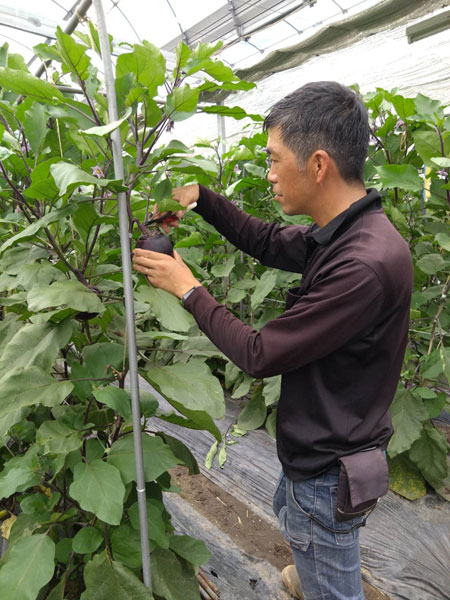
Mr. Morita working in the Kamo eggplant greenhouse
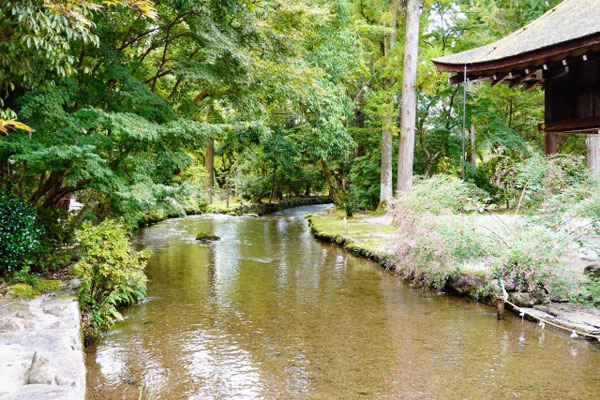
Myojin River flowing through the priest district
A shrine priest town refers to the area where the venerable Kamo clan, who have traditionally presided over the sacred rites of Kamigamo Shrine, have resided.
Kamigamo’s shine priest town is famous for its unique landscape, where old houses surrounded by earthen walls and thatched roofs line up neatly along the clear, murmuring waters of the Myojin River flowing from the grounds of Kamigamo Shrine.
“After all, this intense heat must be affecting the vegetable harvest, right?”
“The impact is severe. Even summer vegetables struggle when temperatures exceed 28℃.
Problems arise with color and shape. Both Kamo eggplants and tomatoes develop tough skins due to the heat.”
“I have heard that summer vegetables in Kamigamo are not available after the end of July.”
“Exactly. In Kamigamo, once September arrives, preparations begin for cultivating a winter specialty called sugi. To tell the truth, eggplants grow until around November. But here, we harvest summer vegetables by the end of July.”
“Summer is famous for Kamo eggplants, tomatoes, cucumbers, and Manganji peppers, but what else do you grow besides suki in winter?”
“Turnips, daikon radishes, Chinese cabbage, spinach, and komatuna greens, among others. When my grandmother was alive, she made pickled Chinese cabbage in rice bran, so we grew a lot of it. Now we grow less cabbage. Since turnips are popular, we’re focusing our efforts on them.”
“One last question: From your perspective as a vegetable grower, could you share any special recommended ways to enjoy Kamo eggplant and Manganji peppers?”
“Kamo eggplant is best enjoyed as dengaku, no question. Manganji peppers are usually grilled and eaten with ginger soy sauce, or simmered together with Kamo eggplant.”
“Thank you very much.”
The conclusion
That concludes my introduction to the story shared by Mr. Morita of “Oideyasu Morita Farm.” While we often hear in the news that “Kamo’s Kyoto vegetables have an exceptional flavor,” opportunities to actually see them sold in town are few and far between, aren’t they?
It is also true that even if there are, the prices at the greengrocer’s who do carry Kamo vegetables are generally quite high.
However, if you visit Kamigamo, you’ll find vending machines scattered everywhere.
Prices vary depending on the farmers’ intentions, but the freshness and taste are guaranteed.
Also, when you have the chance to interact directly with farmers like this time, you can pick out a wider variety of vegetables than you would simply selecting items from a vending machine.
If you have a chance, why don’t you make a visit to Kamigamo once.
Incidentally, I had long assumed that “Oideyasu Morita Farm” had closed permanently, but upon inquiring further, I learned that they are still operating, albeit irregularly.
However, the shop is not open every day as it used to be, so if you plan to visit, please call ahead to confirm.
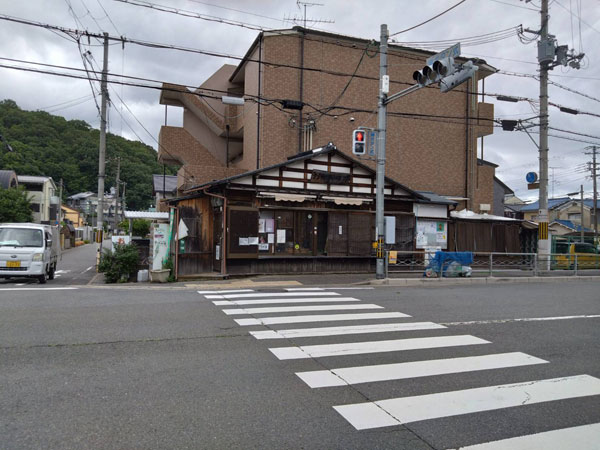
The exterior of the shop “Oideyasu”
The shop currently carries seasonal Kyoto vegetables for spring, summer, autumn, and winter, along with pickled vegetables like suki and stem daikon in winter.
Additionally, depending on the year, homemade umeboshi pickles are also sold.
“Oideyasu Morita Farm”
The address: Kyoto Prefecture Kyoto City Kita Ward Kamigamo Ikebata town 39-1
Tel: 075-712-4889
Transportation access:
Kyoto City bus system 4 in front of the bus stop “Deep Mud Pond” or after getting off at Kyoto Municipal Subway “Kitayama Station” 10-munite-walk from no. 2 exit.
Author
つばくろ(Tsubakuro)
I was born and raised in Kyoto and am a native Kyotoite.
When I was young, I longed to visit Tokyo and Osaka, which are more bustling than Kyoto, but as I have gotten older, I have come to appreciate Kyoto a little more.
In this site, I will introduce you to some of the best places to explore Kyoto's food that you might otherwise miss at first glance.
